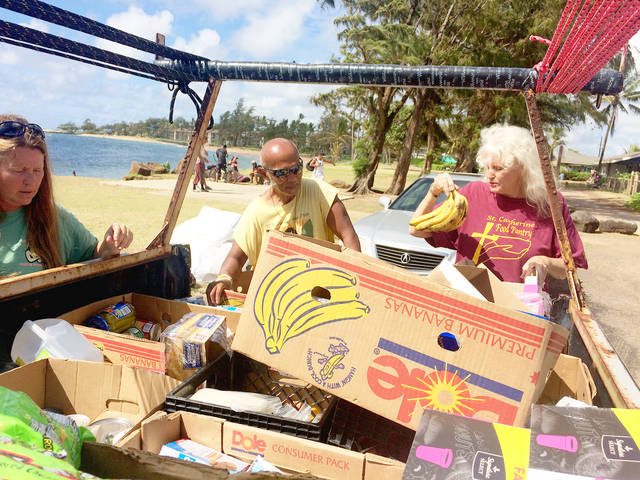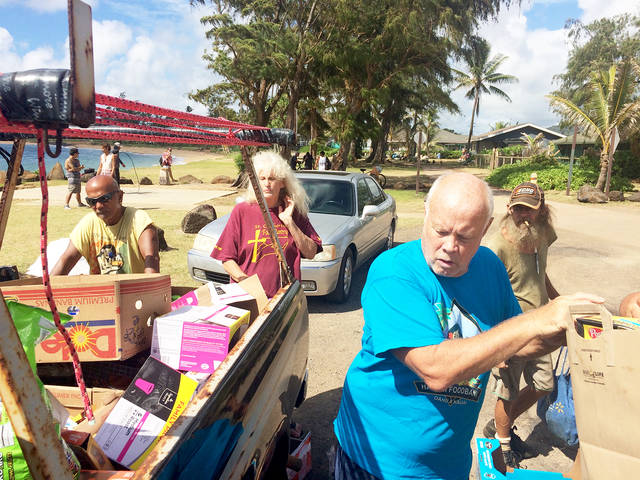KAPAA — The line of people next to the Toyota pickup stretches 15 deep on a Wednesday morning at the parking lot fronting Kapaa Beach Park.
One by one, they make their way to the four volunteers distributing an array of food piled high in the truck’s bed. As one man holds up a bag, Steve Jackson asks what he needs. They trade questions and answers.
“Coffee?”
“Sure.”
“How about some granola bars, energy bars?
“Please.”
“Cookies?”
“Sure, my neighbor likes cookies.”
“Cereal?”
“No thank you.”
“Oatmeal? Popcorn?”
“I’m good. Thank you.”
Jackson nods and smiles.
“Aloha.”
The man smiles back.
“Thank you so much. Have a great day, God bless you,” he says.
A woman steps toward Jackson.
“Hey Michelle, how are you dear?” he says.
This is the way it goes for about an hour during the distribution of free food that goes on each Wednesday morning. It’s the first of three stops, with two more coming near the Lihi Park boat harbor and Fuji Beach.
The volunteers will keep at it until either the food runs out, or the people stop coming. Usually, the food runs out first.
“Lots of new folks I haven’t seen before,” Jackson says.
On this day, the giveaway includes rice, bananas, apples,water, cereal, carrots, bread and more. Always popular is the candy. Everyone likes the sweets, says Jackson, chuckling.
“It’s different every week,” Jackson says. “We have Lunchables today, which is a rarity for us.”
The free food doesn’t just attract homeless folks. There are those with jobs, professionals, families and some squeaking by who rely on the food to get them through another week. These aren’t all Mainland transplants, homeless, as some like to believe. This group includes long-time families – grandparents, parents and children.
Some are carrying what could be everything they own. They walk away holding their grocery bag of food and backpacks with supplies and clothes, slung over their shoulder.
“We see all sorts here,” Jackson says.
Before the day is over, they might help 100 people.
They pick up the food each Tuesday at the food bank, then deliver it to the St. Catherine Catholic Church food pantry, which is their base point of operations. They prepare there for their distribution, and store supplies there.
From April to June, the food pantry served 2,638 adults and 1,506 children. The outreach — distribution at beaches and deliveries to elderly or shut-ins — has become larger than the church food pantry distribution.
That’s also because some can’t make it to the church.
“So we bring it to them,” Jackson says.
This volunteer team, Jackson, Katherine Miles, and a man who goes by Uncle Two Socks, is led by Penny Korte.
This is something she and Jackson have done for a few years. It’s important to acknowledge people, to let them know somebody cares, that they matter, the volunteers say. A smile, a friendly wave, are part of the free food.
“I think we have to take care of ourselves and we have to take care of everybody around us,” Korte says. “That’s our job as humans, to take care of other humans.”
It’s hard out there, Korte says. She knows people are struggling.
“For me, I get a lot of reward. Everybody is very grateful and happy, usually everything goes great,” she says. “And it keeps people from begging on the street, it keeps their dignity and pride. They get to shop instead of trying to get handouts.”
“Anything that helps people get by,” she adds.
That’s a lot of people.
The St. Catherine food pantry, since February 2010, has served over 500,000 meals. It has an estimated 40 volunteers putting in 90 hours a week.
Regulars and newbies show up at distribution points on Wednesday mornings.
“You meet the people that really need it. You’d be surprised how many need,” Korte says.
Uncle Two Socks, retired, says these are his friends. He often rides his bike on Ke Ala Hele Makalae and waves to them, and stops to talk.
He doesn’t like to take much credit for volunteering.
“I’m following Auntie Penny. She’s the leader,” he says. “Whatever she says, we’ll do.”
Katherine Miles began volunteering to distribute the food a few months ago.
“I like doing it. I like doing something for the community,” she says.
Miles turns to help another person.
“How are you, Carla?” she asks.
When they roll up for the 9 a.m. Wednesday giveaway, about 50 men, women of all ages are milling about, waiting.
Miles enjoys meeting the very people’s she signed on to help.
“Most of them are very thankful.” she says. “They’re all very nice.”
Sure enough, the crowd waits patiently. People fill out the required sign up sheet. They write down how many adults and children the food will feed. There’s no pushing or shoving. No one is upset they didn’t get enough.
The closest thing to a complaint comes from one friendly woman, but it’s not really a complaint, just more of a comment.
“I didn’t get no candy,” she says, laughing. “I helped myself to bread, though,” she adds.
Jackson, by the way, is coming off partial knee replacement surgery. Yet, he’s still volunteering, walking, joking and smiling with many who are counting on him.
He’s glad to be there.
“It makes you feel good to be able to give something back to people,” he says. “It’s fun. It’s just good to be able to help people.”
Korte simply says giving to those who would otherwise go without, who would otherwise go hungry, needs to be done.
“We’ll be here until people don’t need it,” she says. “That might be a long time on Kauai.”




A simple question? Does giving out free food by a church etc. create more people who will accept a lower standard of living in the government environment that includes easy to get welfare, food stamps, free medical care and all the rest? For half of our Country’s existence the government stayed out of the free stuff business and let the churches handle that exclusively. Many think people and society were better off then. Churches actually did it better! Thank you for getting involved and providing this function. More churches should follow your lead! And government should get out of the free stuff without reciprocal work business!